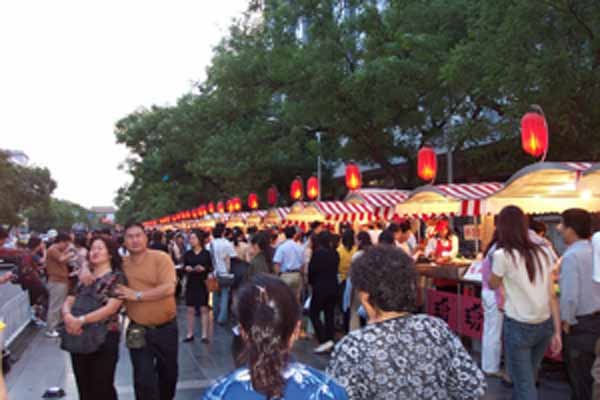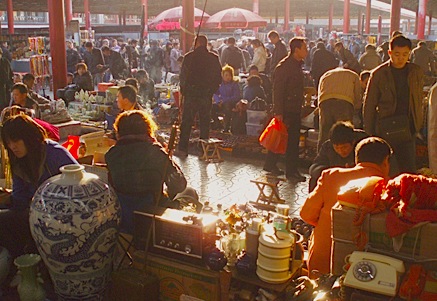| |
Beijing Antique Market is BeijingĄ¯s biggest and best-known arts, crafts, and antiques market, the Chinese name is called "Panjiayuan". Everything is 'antique', pottery, lacquer ware, porcelain, paintings, clocks, statuettes, beads, jade, coins, brass-ware, books, records, fans. A visit to the market has become as important a part of a foreignerĄ¯s tour in Beijing as the Great Wall, the Peking duck, and the Forbidden City.
History
This spontaneous market came into being in 1992 as a roadside market. As trade in folk antiques and handiwork grew, it had become a large antique and handiwork market spreading folk culture in 2002. Many Chinese antique collectors believe that they started their career in Panjiayuan. A visit to the market has become as important a part of a foreignerĄ¯s tour in Beijing as the Great Wall, the Peking duck, and the Forbidden City.
In 2004, at the prize-awarding ceremony of the first Annual Top Ten Lists of Collection in China, the market was elected one of the top ten antique markets in China.
Layout of the Market
The market is divided into five parts:
1. Buddhism Statues Area. in the western part of the market, it is an open-air area where large stone sculptures are sold out of trucks.
2. Antique Furniture Area. besides Buddhism Statues Area, two-storied building that houses traditional furniture and Cultural Revolution articles.
3. High-rank Antique Store Area. more exquisite and more expensive handicrafts were sold in the small indoor stores.
4. Books and Scrolls Area. a narrow lane in the south where secondhand books and ancient scrolls are sold.
5. Middle Area. a semi-covered area that forms the main part of the market. This is open only at the weekends.
Middle Area has four zones:
Zone One. a dizzying array of Chinese paintings, calligraphic works as well as beads and jade.
Zone Two. beads, bronze vessels, ceramic vases and small wooden furniture.
Zone Three. Chinese ethnic minority arts and crafts, trinkets, antiques and apparel. Many of these traders are from Tibet.
Zone Four. Chinese ceramics
On weekends the number of customers reaches 60,000~70,000 a day, including over 10,000 foreigners. Here tourists with different skin colors, speaking different languages, from different classes, and having different beliefs are intermingled. Dozens of important foreign politicians, such as Hillary Clinton, Speaker of the U.S. House of Representatives Dennis Hastert, Greek Prime Minister Costas Simitis, Romanian Prime Minister Nastase, Sri Lankan President Chandrika Kumaratunga, and Thai Princess Sirindhorn have visited the market and bought things here. Some of them spend a very long time here, stopping before every stall.
Nearly the whole range of desired objects can be found here: snuff bottles made in Hengshui, Yangliuqing New Year paintings, embroidery made in Jiangsu, wood carvings from Dongyang, stone carvings from Quyang, shadow play paraphernalia from Shandong, porcelain and crystal ornaments from Jiangxi, boccaro wares from Yixing, bronze wares from Shaanxi, costumes from Yunnan, Tibetan Buddhist articles, white jade from Xinjiang, and Jiaozhi pottery from Taiwan. These folk handicrafts are gathered in the market before being distributed all over the world. Not all the antiques are genuine so if you need certainty it is probably best to shop elsewhere. However, if you are more interested in hunting down the bargain, or are just interested in finding something you like, this is the place.
|






